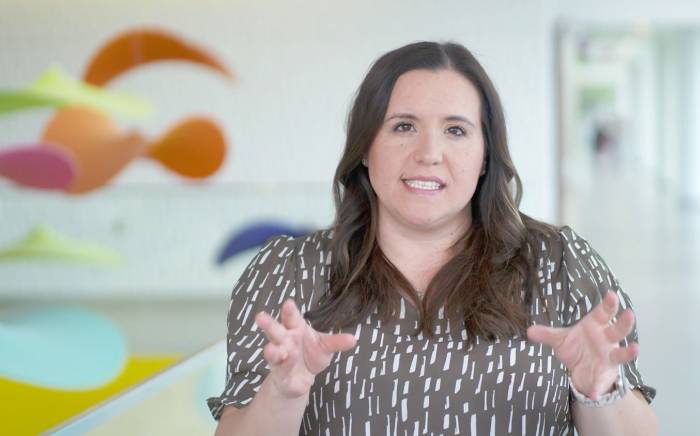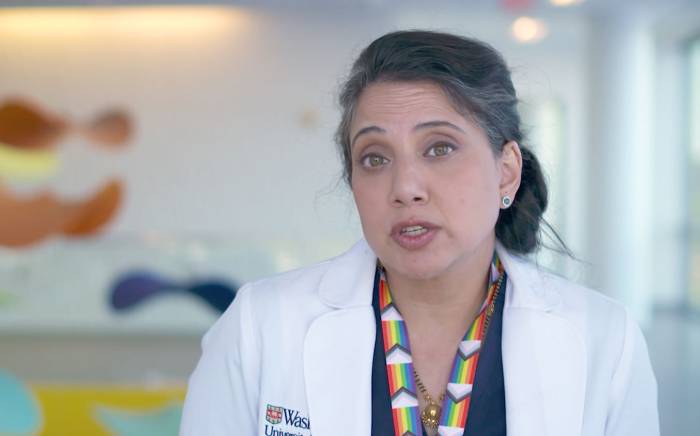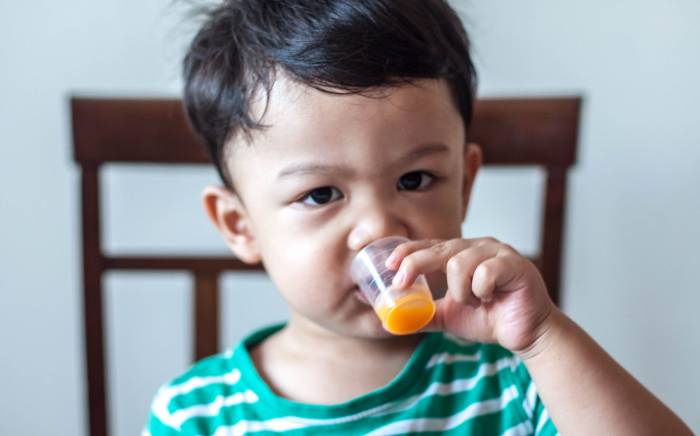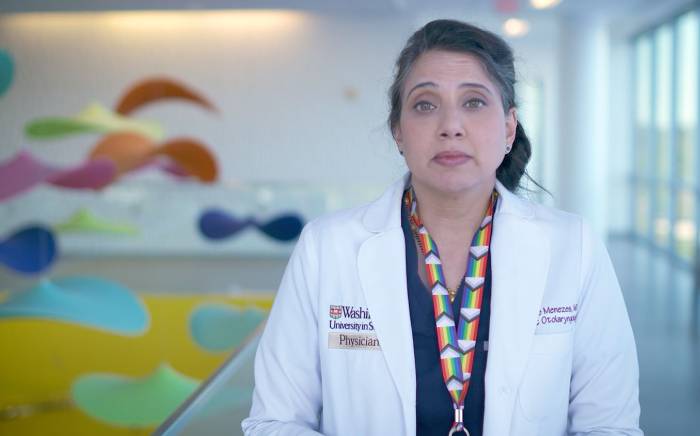Overview
Psoriatic arthritis is a rare form of arthritis or joint inflammation that affects both skin and joints. It can occur in people who have psoriasis, a skin and nail disease. Psoriasis is an ongoing (chronic) condition that causes a red, scaly, itchy rash. It also causes nails to become thick and pitted with tiny holes.
Psoriatic arthritis causes painful joint pain and swelling, along with skin rashes. It most often affects finger and toe joints. But it can also affect wrists, knees, ankles, and the lower back.
This condition is most common in adults ages 30 to 50. But it can begin in childhood. In many cases, the skin disease starts before the arthritis.
Early diagnosis and treatment helps to ease pain and prevent joint damage from getting worse.
Causes
The cause of psoriatic arthritis isn’t known. But things such as a child’s immune system, genes, and the environment may play a role. Children with this condition often have a family member with arthritis or psoriasis.
Symptoms
The skin condition psoriasis may start before or after the arthritis. Psoriasis causes a scaly, red, itchy rash on the knees, elbows, scalp, face, and the folds of the buttocks. It can also cause pitting of fingernails or toenails.
Each child’s symptoms may vary. Symptoms of psoriatic arthritis may include:
- Inflamed, swollen, and painful joints, usually in the fingers and toes
- Morning stiffness in the joints
- Reddened skin over the affected joints
- Sausage-like swelling of fingers and toes, plus swollen wrists (more common in girls age 1 to 6)
- Deformed joints from chronic inflammation
- Symptoms in the spine or sacroiliac joint (more common in older children)
- Eye pain
- Lack of energy (fatigue)
The symptoms of psoriatic arthritis can seem like other health conditions. Make sure to see your child’s healthcare provider for a diagnosis
Diagnosis
Psoriatic arthritis is easier to confirm if your child already has psoriasis. If the skin symptoms have not yet occurred, diagnosis is more difficult. Your child’s healthcare provider will take your child’s medical history and do a physical exam. The provider will ask about your child's symptoms. Your child may have blood tests such as:
- Erythrocyte sedimentation rate (ESR or sed rate). This test looks at how quickly red blood cells fall to the bottom of a test tube. When swelling and inflammation are present, the blood's proteins clump together and become heavier than normal. They fall and settle faster at the bottom of the test tube. The faster the blood cells fall, the more severe the inflammation.
- Uric acid. High blood uric acid levels are linked to psoriatic arthritis.
- Complete blood count (CBC). This test checks for low counts of red blood cells (anemia), white blood cells, and platelets.
- Antibody blood tests. These tests are done to look for certain kinds of proteins, called antibodies, in your blood. These tests can be positive for many kinds of rheumatic diseases. Younger children are more likely to have a positive antinuclear antibody (ANA) test.
Other tests may include:
- X-rays. This test uses a small amount of radiation to create images of organs, bones, and other tissues.
- Eye exam. This is done by a pediatric eye doctor (ophthalmologist). The exam looks for uveitis, a swelling of the middle layer of the eye.
Treatment
Your child's healthcare provider will figure out the best treatment plan for your child based on:
- How old your child is
- Your child’s overall health and medical history
- How sick your child is
- How well your child handles certain medicines, treatments, or therapies
- If your child’s condition is expected to get worse
- The opinion of the healthcare providers involved in your child's care
- Your opinion and preference
The treatment team will include your child's primary healthcare provider. It will also include a pediatric rheumatologist, and an ophthalmologist.
Treatment is done for both the skin condition and the joint inflammation. Some medicines used to treat psoriatic arthritis include:
- Nonsteroidal anti-inflammatory drugs (NSAIDs) to relieve symptoms. These include aspirin, ibuprofen, and naproxen.
- Medicines that weaken the body’s immune system (immunosuppressives). These can be used to ease inflammation if NSAIDs are not working.
- Vitamins and minerals to slow bone deformities. These include calcium and vitamin D.
- Biologic medicines such as infliximab
- Corticosteroids to ease redness and swelling
Other treatment may include:
- Ultraviolet light treatment (UVB or PUVA)
- Heat and cold
- Splints
- Exercise
- Physical therapy to improve and keep muscle and joint function
- Occupational therapy to improve ability to do activities of daily living
- Managing the psoriasis skin rash
- Surgery to fix or replace a damaged joint (often not needed until years after diagnosis)
Complications
Children with psoriatic arthritis are at risk of having an eye condition called uveitis. This is an inflammation of the eye’s middle layer.
With early diagnosis and treatment, children can go into remission. This means that symptoms go away. But when treatment is delayed, remission is less likely. Then the condition may lead to long-term disability.
Living with
Help your child manage his or her symptoms by sticking to the treatment plan. This includes getting enough sleep. Encourage exercise and physical therapy and find ways to make it fun. Work with your child's school to make sure your child has help as needed. Work with other caregivers to help your child take part as much possible in school, social, and physical activities. Your child may also qualify for special help under Section 504 of the Rehabilitation Act of 1973. You can also help your child find a support group to be around with other children with pediatric arthritis.
Key Points
- Psoriatic arthritis is a rare form of arthritis or joint inflammation that affects both skin and joints. It can occur in people who have the skin disease psoriasis.
- It is most common in adults ages 30 to 50. But it can begin in childhood.
- This condition causes inflamed, swollen, and painful joints. It also causes eye pain and fatigue.
- Treatment may include medicines, heat and cold, splints, exercise, physical therapy, and surgery.
- Early treatment can help the disease go into remission. Delayed treatment may lead to long-term disability.
Next Steps
Tips to help you get the most from a visit to your child’s healthcare provider:
- Know the reason for the visit and what you want to happen.
- Before your visit, write down questions you want answered.
- At the visit, write down the name of a new diagnosis, and any new medicines, treatments, or tests. Also write down any new instructions your provider gives you for your child.
- Know why a new medicine or treatment is prescribed and how it will help your child. Also know what the side effects are.
- Ask if your child’s condition can be treated in other ways.
- Know why a test or procedure is recommended and what the results could mean.
- Know what to expect if your child does not take the medicine or have the test or procedure.
- If your child has a follow-up appointment, write down the date, time, and purpose for that visit.
- Know how you can contact your child’s provider after office hours. This is important if your child becomes ill and you have questions or need advice.









